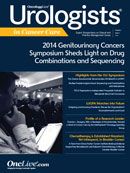Brisk Walking May Lower Prostate Cancer Aggressiveness
Brisk walking helps normalize the shape of vessels in prostate cancer tumors, which may make the tumors less aggressive and more responsive to anti-cancer therapies
Erin van Blarigan, ScD
Brisk walking helps normalize the shape of vessels in prostate cancer tumors, which may make the tumors less aggressive and more responsive to anti-cancer therapies, a team of investigators reported at the AACRProstate Cancer Foundation Conference on Advances in Prostate Cancer Research, held January 18-21 in San Diego, California.
The study’s authors, van Blarigan et al, had demonstrated in a previous study that higher amounts of small, irregularly spaced vessels in human prostate tumors resulted in a greater risk for lethal disease. They embarked on the current investigation because of other previous data showing that exercise normalized tumor vasculature in mice with prostate cancer; in addition, the authors wrote, brisk walking and vigorous activity have been associated with a lower risk of prostate cancer recurrence and mortality in humans.
In the retrospective study, the team looked at prediagnostic physical activity and vessel morphology in 572 men who underwent radical prostatectomy or transurethral resection of the prostate. The men were all participants in the Health Professionals Follow-up Study, launched in 1986 to consider the effects of nutritional and lifestyle factors on the incidence of serious illnesses, such as cancer and heart disease. Every 2 years, participants fill out questionnaires that gauge whether they have diseases and what medications they take, as well as their involvement in activities such as smoking and exercise. The men fill out questionnaires about their dietary habits every 4 years.
Before being diagnosed, the men had filled out an average of nearly 5 questionnaires assessing their levels of total, vigorous, and nonvigorous activity, as well as their walking pace. Vessel morphology—including vessel size, regularity of the vessel lumen, and microvessel density—was assessed through the analysis of tumor-section images stained to detect the expression of the protein CD34. The team of investigators considered the relationship between the cohort’s level of physical activity and their vessel morphology.
They found that prediagnosis brisk walking was associated with more regularly shaped vessels in prostate tumors. Men who walked the fastest, from 3.3 to 4.5 miles per hour, had 8% more regularly shaped vessels than men who walked the most slowly, from 1.5 to 2.5 miles per hour (P = .01). Brisk walking was also associated with larger vessels (P = .06).
Walking pace did not demonstrate any effect on microvessel density, and the amount of time spent walking did not prove meaningful when it came to vessel morphology in general. The authors suggested that further studies should investigate whether increasing brisk walking after prostate cancer diagnosis will fuel positive changes in a man’s tumor vasculature.
Reference
van Blarigan EV, Gerstenberger J, Jones L, et al. Physical activity and tumor vessel morphology among men with prostate cancer. Presented at: the AACR-Prostate Cancer Foundation Conference on Advances in Prostate Cancer Research; January 18-21, 2014; San Diego, California. Abstract 275791_1.




